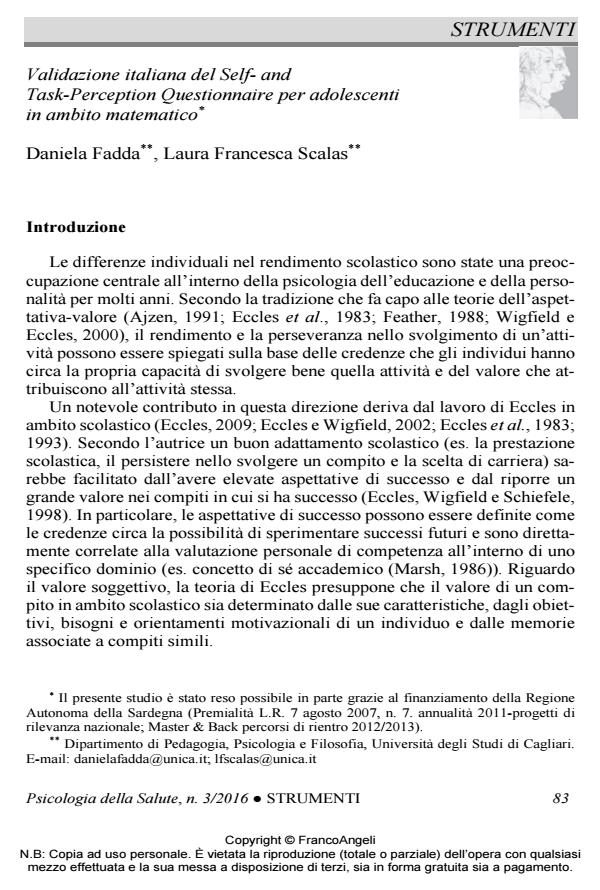Validazione italiana del Self- and Task-Perception Questionnaire per adolescenti in ambito matematico
Titolo Rivista PSICOLOGIA DELLA SALUTE
Autori/Curatori Daniela Fadda, Laura Francesca Scalas
Anno di pubblicazione 2016 Fascicolo 2016/3
Lingua Italiano Numero pagine 19 P. 83-101 Dimensione file 255 KB
DOI 10.3280/PDS2016-003005
Il DOI è il codice a barre della proprietà intellettuale: per saperne di più
clicca qui
Qui sotto puoi vedere in anteprima la prima pagina di questo articolo.
Se questo articolo ti interessa, lo puoi acquistare (e scaricare in formato pdf) seguendo le facili indicazioni per acquistare il download credit. Acquista Download Credits per scaricare questo Articolo in formato PDF

FrancoAngeli è membro della Publishers International Linking Association, Inc (PILA)associazione indipendente e non profit per facilitare (attraverso i servizi tecnologici implementati da CrossRef.org) l’accesso degli studiosi ai contenuti digitali nelle pubblicazioni professionali e scientifiche
All’interno dell’ambito delle teorie dell’aspettativa-valore, il presente studio è volto alla validazione italiana del Il Self ? and Task ? Perception Questionnaire (STPQ) per adolescenti messo a punto da Eccles e colleghi per la misura dell’aspettativa, del valore soggettivo e della difficoltà percepita per un dato compito in ambito accademico. Lo strumento, composto da 19 item con un formato di risposta a sei punti, ha mostrato in letteratura buone qualità psicometriche e la capacità di predire la prestazione e i comportamenti di scelta di carriera degli studenti. Nel presente studio si è presa in considerazione la motivazione verso l’apprendimento della matematica in un campione di 440 studenti (232 maschi e 208 femmine) frequentanti l’ultimo anno di licei classici e scientifici. Utilizzando un’analisi fattoriale confermativa gli autori hanno dato supporto alla struttura di primo livello a sei fattori (abilità/aspettativa; valore intrinseco/interesse, valore del risultato/importanza, valore estrinseco/utilità, difficoltà del compito, sforzo richiesto) attesa a livello teorico, la quale è risultata invariante per genere. In linea con quanto trovato a livello internazionale, è emersa inoltre una struttura sovra-ordinata in cui cinque dei sei fattori individuati nell’analisi fattoriale di primo livello vengono aggregati in due fattori di ordine superiore (valore soggettivo del compito, difficoltà percepita). Inoltre, si è supportata la validità di costrutto e predittiva della scala. In conclusione, l’STPQ appare essere un valido ed attendibile strumento per la misura dell’aspettativa, del valore soggettivo e della difficoltà percepita verso la matematica per studenti di scuola superiore.�
Parole chiave:Aspettativa-valore, matematica, validazione, analisi fattoriale confermativa
Daniela Fadda, Laura Francesca Scalas, Validazione italiana del Self- and Task-Perception Questionnaire per adolescenti in ambito matematico in "PSICOLOGIA DELLA SALUTE" 3/2016, pp 83-101, DOI: 10.3280/PDS2016-003005